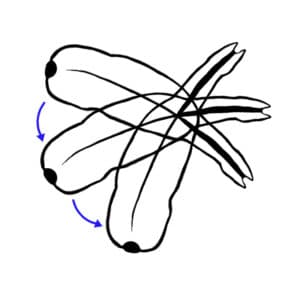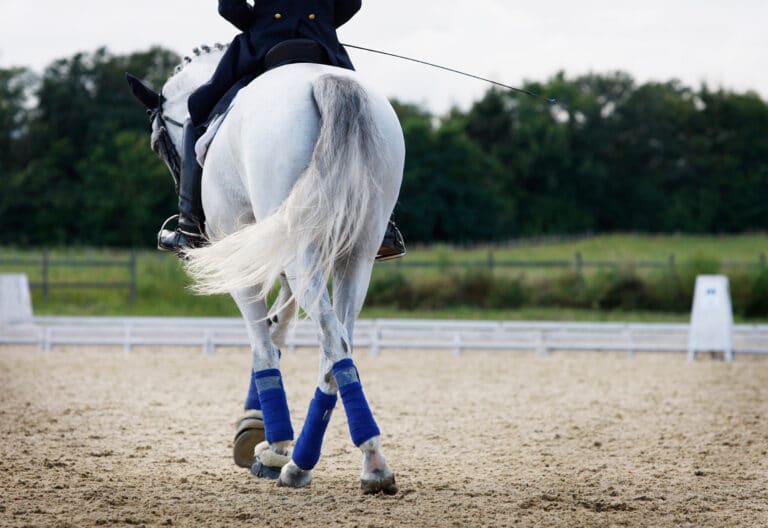Although lateral work might sound fancy it’s really just another term for moving sideways, writes CHRISTINE ARMISHAW.
Having your horse respond effectively to lateral aids is important for any rider at any level, not just for dressage queens riding half-pass in a Grand Prix test. Among other things, you need to be able to move your horse sideways off your leg to ride straight, eliminate crookedness, and to work their body evenly. Real-world examples include getting straight in front of a jump and staying straight to get to the next one; making circles bigger and smaller when schooling; or even getting your horse close enough to a gate to open or close it. It all requires lateral work.
Like everything with horses, when first teaching the concept of sideways, we start off small and build up. If your horse is green or has only recently begun its training, the correct response to the rider’s leg aid up until now will usually only have been to move forward. When lateral work is introduced, this is the first time the rider’s leg takes on a new meaning: to move across to the left or right.
To keep things clear and easy for the equine student, beginning your lateral training from the ground is recommended. A great movement to introduce this new element is the turn on the forehand. This is when the horse’s front feet stay almost in the same spot, or move in a small circle, while the hind quarters pivot around them on a larger circle.
The exercise is fairly straightforward. To move the horse’s quarters right, stand at their left shoulder, holding the reins and facing towards their tail. Adjust the pressure on the reins to prevent the horse stepping forward, without asking them to step a firm contact, but without pulling. Flex the horse slightly to the left, with a little weight in the right hand to stop the horse stepping forward with the front feet. backwards, and with slight flexion to the left. Use a dressage whip to tap, tap, tap a little behind the girth area. Keep tapping until the inside (right) hind leg steps across the front of the outside hind, then immediately stop tapping to take the pressure off. However, if your horse takes a forward or backward step, keep tapping until they move their inside hind leg across.
The caveat here is that if your horse finds it hard and to start with only does a small shuffle step of the inside hind, reward this attempt by removing pressure. In the early stages, rewarding the best attempt towards the outcome you are trying to achieve is the best way to encourage progress towards the desired end result. Aiming for perfection on the first try can result in confusion and thus frustration on your horse’s part.

In a turn on the forehand, the front feet stay almost in the same spot while the hind quarters pivot around them.
Go for one step across at a time, pausing to remove pressure and praise your horse in between each successful movement. You will likely notice them licking and chewing as they start to understand what you are asking. It’s super important to wait until this time of processing is fully finished before asking for another step. Your patience will reward you with a calmer horse overall, and one with a better understanding of what is being requested.
Four individual steps in a row is great progress, after which you can swap to the other side and repeat from your horse’s right hand side. Feeling good and as if you are both on the same page? Super, now it’s time to try it in the saddle!
After a good warm up, using transitions to make sure your horse is on the aids, come to a halt and prepare to move their quarters to the right off your left leg. You will need to stay tall and centred, no leaning forward. Right leg stays on the girth, left leg moves back behind the girth, preparing to push the quarters away. Reins are held in a firm contact, but without pulling. Flex the horse slightly to the left, with a little weight in the right hand to stop the horse stepping forward with the front feet.
Press your lower left leg on and off the horse’s side, backing up the aid by tapping your dressage whip behind your leg, mimicking your earlier teaching from the ground. Adjust your rein pressure: increase if they go to step forward, soften if they try to step back, and pay attention to the feedback they’re giving you. Keep squeezing or tapping until you feel the horse move their quarters to the right, then all leg and rein pressure off and lots of praise! Wait for that lick and chew to finish, then ask again. Be patient, take your time, be quick to correct and even quicker to reward the right thing or an attempt that’s close to it.
If the horse gets frustrated, walk away. Move forwards then halt somewhere else to try again. Aim for four individual steps in a row, then go for a walk before changing sides. Repetition in small amounts, in between other more familiar exercises, will help your horse remain in the calm state that’s perfect for learning.



